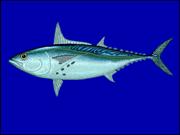
|
||||||
| Fisheries :: Fish Migration | ||||||
|
Fish migration Many types of fish migrate on a regular basis, on time scales ranging from daily to annual, and over distances ranging from a few meters to thousands of kilometers. Fish usually migrate because of diet or reproductive needs, although in some cases the reason for migration remains unknown. Classification Potamodromous fish migrate within fresh water only (Greek: Potamos is river and dromos is 'a running') Oceanodromous fish migrate within salt water only (Greek: 'Oceanos' is ocean) Diadromous fish travel between salt and fresh water (Greek: 'Dia' is between)
Forage fish
Forage fish often make great migrations between their spawning, feeding and nursery grounds. Schools of a particular stock usually travel in a triangle between these grounds. For example, one stock of herrings have their spawning ground in southern Norway, their feeding ground in Iceland, and their nursery ground in northern Norway. Wide triangular journeys such as these may be important because forage fish, when feeding, cannot distinguish their own offspring. Capelin are a forage fish of the smelt family found in the Atlantic and Arctic oceans. In summer, they graze on dense swarms of plankton at the edge of the ice shelf. Larger capelin also eat krill and other crustaceans. The capelin move inshore in large schools to spawn and migrate in spring and summer to feed in plankton rich areas between Iceland, Greenland, and Jan Mayen. The migration is affected by ocean currents. Around Iceland maturing capelin make large northward feeding migrations in spring and summer. The return migration takes place in September to November. The spawning migration starts north of Iceland in December or January. The diagram on the right shows the main spawning grounds and larval drift routes. Capelin on the way to feeding grounds is coloured green, capelin on the way back is blue, and the breeding grounds are red. Highly migratory species
The term highly migratory species (HMS) has its origins in Article 64 of the United Nations Convention on the Law of the Sea (UNCLOS). The Convention does not provide an operational definition of the term, but in an annex (UNCLOS Annex 1) lists the species considered highly migratory by parties to the Convention.
The list includes: tuna and tuna-like species (albacore, bluefin, bigeye tuna, skipjack, yellowfin, blackfin, little tunny, southern bluefin and bullet), pomfret, marlin, sailfish, swordfish, saury and ocean going sharks, dolphins and other cetaceans.
These are high trophic level species which undertake migrations of significant but variable distances across oceans for feeding, often on forage fish, or reproduction, and also have wide geographic distributions. Thus, these species are found both inside the 200 mile exclusive economic zones and in the high seas outside these zones. They are pelagic species, which means they mostly live in the open ocean and do not live near the sea floor, although they may spend part of their life cycle in nearshore waters. (Source:http://en.wikipedia.org/wiki/Fish_migration) |
||||||
© All Rights Reserved. TNAU 2009-15. |
||||||

